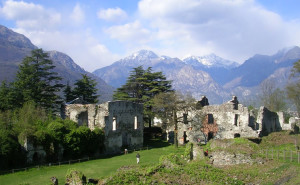Where to go
From the farm you have direct access to the ancient a Via Regina. It is a long path that runs along the entire western shore of Lake Como, passing through the villages and hamlets and goes towards the Spluga pass where it takes the name of Spluga pass patha.
For centuries the Via Regina was a connection road between the South and North of the Alps, the area between Como and Milan and the transalpine regions, through the Spluga and the Maloja passes.
Travel is slow but fascinating and allows you to enjoy beautiful views of magnificient villas, numerous gardens, nature areas and many churches of great artistic interest. Stopping often is an opportunity to discover sudden glimpes and colors of the lake and its environments.
The church of San Miro of Romanesque origin, is probably of the 12th century and mentioned for the first time in a document dated 1286 and now preserved in the archives of the Collegiate Church of Chiavenna.
The church is dedicated to the Saint Miro, a hermit born in Canzo, in the area of the so called a Larian trianglea, the promontory dividing Lake Como into the two branches of Como and Lecco . His tomb conservated into the church became the destination for pilgrimages of many people in the hope of propitiating or inhibiting rainfall.
It is situated in a wonderful position on the slopes of Monte Berlinghera and is reachable only on foot. In the interior you can admire some series of frescos and landscape decoration by Sigismondo de Magistris (1526). There is also a painting of Fiamminghino (1616)
The oratory of San Fedelino, is one of the most valuable monuments ofRomanesque art in Lombardy, and the oldest monument in the area. It lies on a strip of land overlooking the river Mera which enters the lake just beyond Mezzola and is reachable only by foot from the path of aOld Regina or by boat.
Pian di Spagna and Lago di Mezzola Nature Reserve is the ideal place if you want to carry out naturalistic tours or get surrounded by the relaxing atmosphere of nature, and if you want to observe wildlife and its habits.
Many species of birds use this area as their favourite intermediate stopover during their long migratory flights.
The ponds of Peschiera, reachableboth on foot and by mountain bike ;
Albonico , is the last village in the province of Como. In this location exposed to the sun and enjoying a remarkable panoramic view of Lake Mezzola, are located two ponds of natural interest .
The first one is located on the slopes of Mount Peschiera , at an altitude of 586 meters.,
Surrounded by reeds each year it makes possible the nesting of mallards. You can also have the chance to admire the flight of hoopoe and other birds of prey in transit from Monte Berlinghiera towards Pian di Spagna.
The second pond , much smaller , is located on the summit of Mount Peschiera , at 690 meters above sea level ,where deers go to water.
Surrounded by chestnut trees, spruces , birches, oaks, the ponds of Peschiera allow you to appreciate the pleasure of silence . Silence is sometimes interrupted in the summer by the croaking of frogs, the unmistakable song of the cuckoo .
 The Piona Abbey stands in a wonderful position at the end of the Olgiasca peninsula, overlooking the lake with the same name. The history of Piona begins in 610 A.C., when an oratory was founded on the peninsula, dedicated to Santa Giustina. In 1138 it was consecrated. In the XVI century began an unstoppable decline and deterioration of the abbey. . The restoration began in the XX century: it was bought by the Rocca Family and was given in 1937 to the Benedictine Cistercian congregation of Casamari and little by little the building began to return to its original splendor.
The Piona Abbey stands in a wonderful position at the end of the Olgiasca peninsula, overlooking the lake with the same name. The history of Piona begins in 610 A.C., when an oratory was founded on the peninsula, dedicated to Santa Giustina. In 1138 it was consecrated. In the XVI century began an unstoppable decline and deterioration of the abbey. . The restoration began in the XX century: it was bought by the Rocca Family and was given in 1937 to the Benedictine Cistercian congregation of Casamari and little by little the building began to return to its original splendor.
In the Sixties it became an Abbey. The nave has marble lions and frescoes dating from the XII century. We enter the Abbey through the stunning cloister at the side built in 1275 in a combination of the Romanesque and Gothic style, surrounded by refined columns and decorated with paintings from different periods. The complex is entrusted to the Cistercian monks who distil excellent liqueurs and herbs infusions.
 Forte Montecchio, Forte di Fuentes;
Forte Montecchio, Forte di Fuentes;
Forte Montecchio of Colico is the best preserved fortress of the First World War in Europe. The four pieces of artillery, capable of a range of about 8,699 miles, were intended to control the lower Valtellina e Valchiavenna and the northern part of the Lake Como. From the fortress you can enjoy a splendid view of lake Como, Lake Mezzola, the Nature Oasis of Pian di Spagna, the Mount Legnone and the Adda river outfall.
The Fuentes Fort was wanted in 1603 by Count of Fuentes and Milan’s Governor. The fort was built as a bulwark of the borders between the Milan State and The Grigioni Duchy. Because of its strategic position was used by the Italian Army during the First World War and cannon sites were built. They still exist today.


